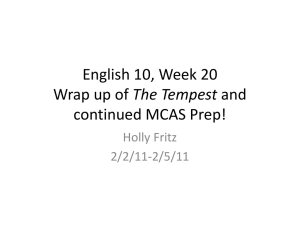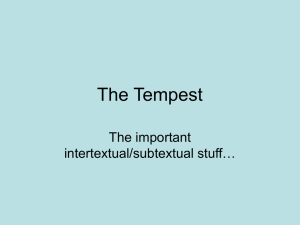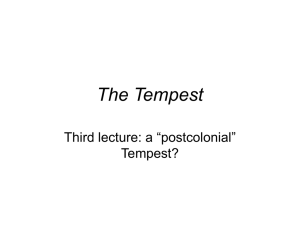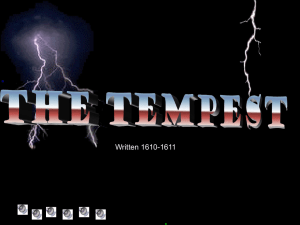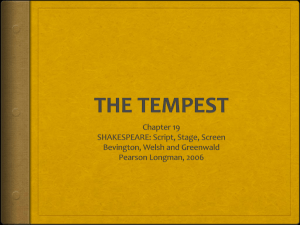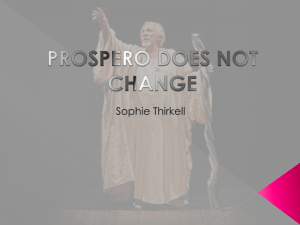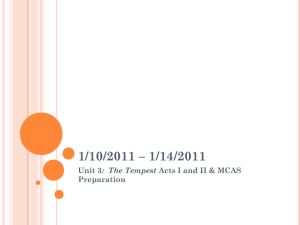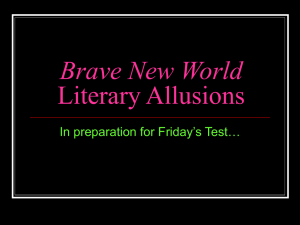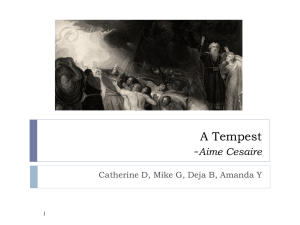The Tempest
advertisement
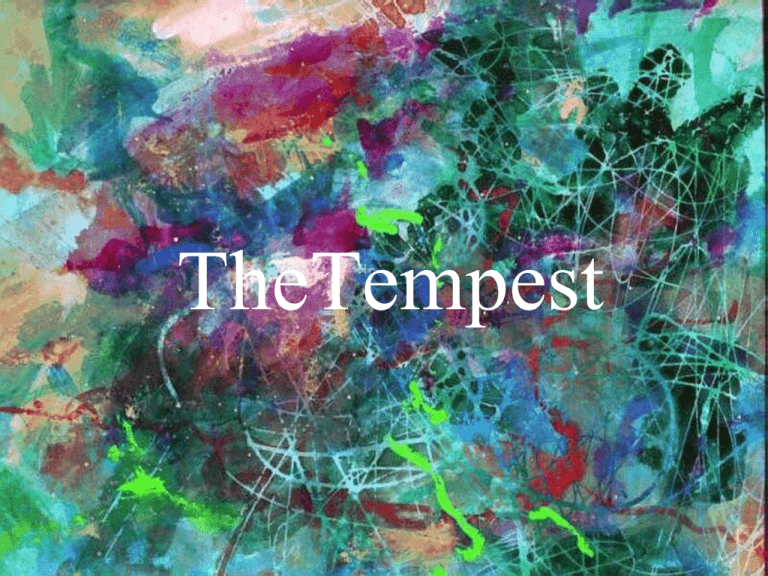
TheTempest William Shakespeare’s The Tempest Generally regarded as Shakespeare’s last play: 1611 Performed for King James I and at the marriage festivities of his daughter Elizabeth Source: William Strachey’s account of the shipwreck of the Sea Venture in 1609 Paul Falconer Poole. A Scene from the Tempest, 1856. Prospero Duke of Milan Antonio usurper Miranda Sycorax Caliban Alonso Sebastian King of Naples Ferdinand Ariel Iris Ceres Juno Nymphs Gonzalo, Counselor Trinculo, Jester Stephano, Butler Adrian, Francisco Shipmaster, Boatswain, etc. John William Waterhouse, Miranda-The Tempest, c. 1916 “If by your art, my dearest father, you have put the wild waters in this roar, allay them” Rulers and subjects Themes Right relationship Responsibilities Master/Servant Revenge or mercy Sibling rivalry Commentary on European exploration of new lands Utopianism Colonialism Imperialism “The Other” Nature of indigenous peoples The role of the artist Autobiographical? Prospero by Lisa Iris Post-Colonial Theory & The Tempest During the 15th Century until the 19th Century (1400s-1800s) Europe began its first colonial wave. This was a common occurrence in Shakespeare’s time. The earth was being “discovered” and stories were coming back from distant lands. There were myths about the “cannibals” of the Carribean, of true Edens and distant utopias (an ideally perfect place) Post-Colonial Theory & The Tempest With the character Caliban (whose name is roughly anagrammatic to Cannibal), Shakespeare may be offering an in-depth discussion into the morality of colonialism. Different views of this are found in the play, with examples including Gonzalo’s Utopia, Prospero’s enslavement of Caliban, and Caliban's subsequent resentment. Caliban is also shown as one of the most natural characters in the play, being very much in touch with the natural world; Post-Colonial Theory & The Tempest From the mid 1950s more and more academics have studied The Tempest through a post-colonial lens. This new way of looking at the text explored the effect of the coloniser (Prospero) on the colonised (Ariel and Caliban). Post-colonial theory in The Tempest The Tempest explores many different aspects of colonialism: Europeans’ appropriation of and exploitation of foreign territories Europeans’ subordination of indigenous populations (such as the different treatment of Caliban and Ariel) Europeans’ claims that they are colonizing to bring Christianity and civilization ( Europeans’ use of colonialism as a way to let off pressure from their own social Post-colonial theory in The Tempest Caliban has been ensalved, as was the case of native people being "colonized" by conquering nations. He suffers as a result, receiving alcohol and misunderstanding the "gift" and the giver because he is not accustomed to this culture. He reacts by devising a plot, wanting Stephano to be leader of the island. He struggles against his enslavement, but like so many colonies, he does not realize that his own choice of leader could be just as destructive. “The Other” Caliban by Edmund Dulac Colonising Caliban More important than the emphasis on the way in which Caliban seems to others more monster than man, is the way in which this scene dramatizes the initial encounter between an almost completely isolated, “primitive” culture and a foreign, “civilized” one. The reader discovers during Caliban and Prospero’s confrontation in Act I, scene ii that Prospero initially “made much of” Caliban (II.ii.336); that he gave Caliban “Water with berries in’t” (II.ii.337); that Caliban showed him around the island; and that Prospero later imprisoned Caliban, after he had taken all he could take from him. The reader can see these events in Act II, scene ii, with Trinculo and Stephano in the place of Prospero. Stephano calls Caliban a “brave monster,” as they set off singing around the island. In addition, Stephano and Trinculo give Caliban wine, which Caliban finds to be a “celestial liquor” (II.ii.109). Moreover, Caliban initially mistakes Stephano and Trinculo for Prospero’s spirits, but alcohol convinces him that Stephano is a “brave god” and decides unconditionally to “kneel to him” (II.ii.109–110). This scene shows the foreign, civilized culture as decadent and manipulative: Stephano immediately plans to “inherit” the island (II.ii.167), using Caliban to show him all its virtues. Stephano and Trinculo are a grotesque, parodic version of Prospero upon his arrival twelve years ago. Godlike in the eyes of the native, they slash and burn their way to power. Gonzalo’s Idea of Governance Gonzalo’s fantasy about the plantation he would like to build on the island is a remarkable poetic evocation of a utopian society, in which no one would work, all people would be equal and live off the land, and all women would be “innocent and pure.” This vision indicates something of Gonzalo’s own innocence and purity. Stephano’s Idea of Governance Stephano muses about the kind of island it would be if he ruled it—“I will kill this man [Prospero]. His daughter and I will be King and Queen . . . and Trinculo and thyself [Caliban] shall be viceroys” (III.ii.101–103) Stephano wants to employ a totalitarian type of regime. This contrasts significantly with Gonazalo’s vision. Totalitarian: where an individual dictator monopolises political power and controls every element of society. Doubles: A predominant technique. As we have seen, one of the ways in which The Tempest builds its rich aura of magical and mysterious implication is through the use of doubles: scenes, characters, and speeches that mirror each other by either resemblance or contrast. Caliban/Stephano/Trimnculo double and parody what Prospero does throughout the play. The three wander aimlessly about the island, and Stephano muses about the kind of island it would be if he ruled it, just as Gonzalo had done while wandering with Antonio and Sebastian in Act II, scene i. The power-hungry servants Stephano and Trinculo thus become rough parodies of the power-hungry courtiers Antonio and Sebastian. All four men are now essentially equated with Caliban, who is, as Alonso and Antonio once were, simply another usurper. The Feminist Critique The Feminist Critique The Tempest has only one female character, Miranda. Other women, such as Caliban's mother Sycorax, Miranda's mother and Alonso's daughter Claribel, are only mentioned. Because of the small role women play in the story in comparison to other Shakespeare plays, The Tempest has not attracted much feminist criticism. Miranda is typically viewed as being completely deprived of freedom by her father. Her only duty in his eyes is to remain chaste. It has been argued that she is typical of women in a colonial atmosphere, has completely accepted the patriarchal order of things, thinking of herself as subordinate to her father. The less-prominent women mentioned in the play are subordinated as well, as they are only described through the men of the play. Most of what is said about Sycorax, for example, is said by Prospero. Prospero has never met Sycorax — all he learned about her he learned from Ariel. It can be argued that Prospero's suspicion of women makes him an unreliable source of information. SHAKESPEARE’S RECURRING COMEDIC THEMES: INTERTEXTUAL RELATIONSHIPS WITH OTHER COMEDIES In this play are themes of love at first sight, magic as a controlling device, revenge, usurpation & inordinate ambition. What other plays deal with these themes? To what extent are they similar? Discuss with a mate and feed back… Love at First Sight Revenge Magic Usurpation and inordinate ambition Tempest, Hear my soul speak. Of the very instant that I saw you, Did my heart fly at your service As You Like It: (Orlando & Rosaline) Who ever loved that loved not at first sight? Midsummer Night’s Dream (Titania & Bottom), Romeo & Juliet Tempest: Prospero seeks revenge against Sebastian and Alonso. Caliban seeks revenge against Prospero. It’s used to correct behaviour. Tempest: Prospero, with the help of his books is able to use magic to seek his revenge, and to control Caliban. Midsummer: There is a magical world in which the fairies exist. Tempest: Antonio usurps Prospero’s place as Duke of Milan. Sebastian attempts to usurp Alonso’s place as King of Naples. As You Like It: Also illustrates usurpation and ambition. Midsummer: Oberon seeks revenge against Titania and makes her fall in love with Bottom. Revenge is used to correct behaviour. Ariel confronting the “three men of sin” by Edmund Dulac Edward A. Wilson Other Tempests Literary Adaptations of The Tempest Auden, W. H. "The Sea and the Mirror" (1944) on W.H. Auden: [http://www.kirjasto.sci.fi/whauden.htm] Barnes, Charlotte (Mary Sanford) The Forest Princess, or Two Centuries Ago (play, online) (1844) Brathwaite, Kamau (1930-). "Caliban" (poem) sites on Brathwaite Brough, William and Robert Brough. The Enchanted Isle. 1848. Browning, Robert (1812-1889). Caliban upon Setebos, or Natural Theology in the Island. Césaire, Aimé. A Tempest (Une Tempête, d'après La tempête de Shakespeare: adaptation pour un théâtre nègre. Paris: Seuil, 1969.) Bibliography and links to Césaire Davenant, William and John Dryden. The Tempest or the Enchanted Island. 1670. (play) ed. Jack Lynch. [http://andromeda.rutgers.edu/~jlynch/Texts/tempest.html] Dryden, John, William Davenant and Thomas Shadwell. The Tempest. 1674. (opera) composers: Henry Purcell, John Bannister, Pelham Humphrey, Pietro Reggio, James Hart, Matthew Locke. Duffet, Thomas. The Mock Tempest or the Enchanted Castle. 1675. Ferlinghetti, Lawrence. "Caliban". Ferlinghetti, biography, some poems Homolka, Kurt. Die Wunderinsel (1958) Oper mit Ballet. Libretto (arrangement of Schubert's Alfonso und Estrella) Hughes, Ted. (1930-1998) "Setebos". Ted Hughes Criticism page Johnson, Lemuel. Highlife for Caliban Literary Adaptations of The Tempest MacKaye, Percy. Caliban by the Yellow Sands. 1916. (play) Malouf, David. Blood Relations. 1987. (play) Murrell, John. New World. 1985.(play) Nunez, Elizabeth, Prospero’s Daughter: A Novel. 2006. Osment, Phillip. This Island's Mine. 1988. (play) Plath, Sylvia (1933-1963) "Ariel" (and other poems; Popular novels and romances: Boucher, Rita. The Would-Be Witch; James, Deanna. Acts of Love; Kelly, Carla. Miss Grimsley's Oxford Career; Kidd, Elizabeth. My Lord Guardian, commented by Osborne, Laurie, Romancing the Bard Renan, Ernest. L'Eau de Jouvence. 1879.(play) Schmidt, Arno. Caliban über Setebos. (short story) über Arno Schmidt Schober, Franz von. Alfonso und Estrella. libretto (1821) (Franz Schubert) Shelley, Percy Bysshe. (1822) With a guitar, to Jane. aka. To a Lady, with a guitar. (Ariel to Miranda) Warner, Marina. Indigo. chapter 19; Indigo: Mapping the waters; interviews and articles Wells, H. G. The Island of Dr Moreau (1896) . Film Adaptations of The Tempest Bender, Jack. (dir.) The Tempest. (USA; set in the Mississippi Bayous during the Civil War) 1998] Stangertz, Gören. (dir.) Stormen (Sweden, 1998) Sokolov, Stanislav. (dir.) The Tempest (Animation, Russia, 1992) Greenaway, Peter. (dir.) Prospero's Books (I, 1991), John Gielgud as Prospero. Ählin, Per. (dir.) Resan till Melonia (Norw./Sweden 1989)] Taymor, Julie. (dir.) The Tempest (USA, 1986) Woodman, William. (dir.) The Tempest (USA; 1983) Mazurski, John. (dir.) The Tempest (USA, 1982) Stanley, Audrey. (dir.) The Tempest (USA, 1980) Gorrie, John. (dir.) The Tempest (BBC, 1980) Jarman, Derek. (dir.) The Tempest (UK, 1979) Coleman, Basil. (dir.) The Tempest (UK, 1968) Schaefer, George. (dir.) The Tempest (USA, 1960) Richard Burton as Caliban. Atkins, Robert. (dir.) The Tempest (UK, 1956) Wilcox, Fred M. (dir.) The Forbidden Planet (science fiction 1956) Wellman, William (dir.) Yellow Sky (Western, USA 1948) Bower, Dallas. (dir.) The Tempest (UK, 1939) Thanhouser, Edwin (dir.) The Tempest (silent, USA 1911)
